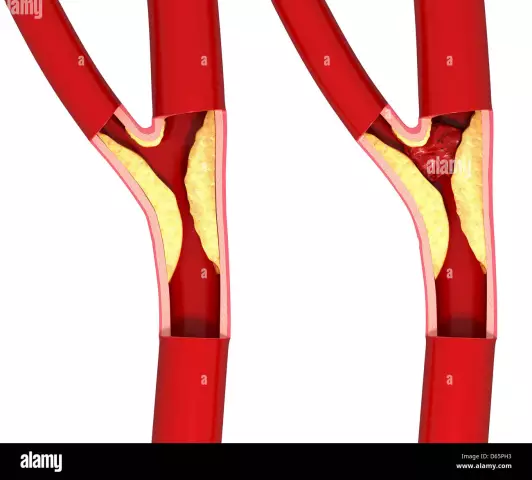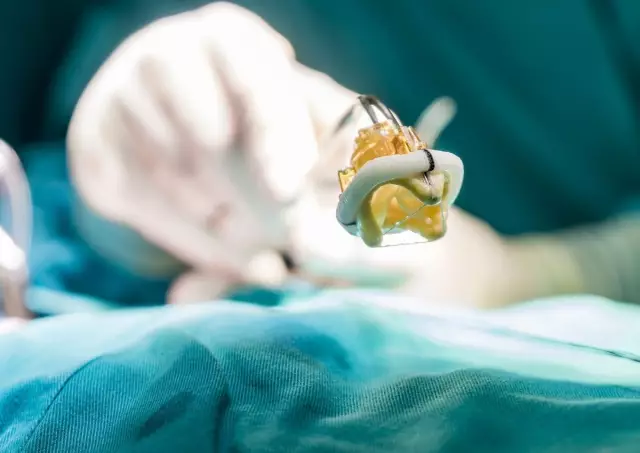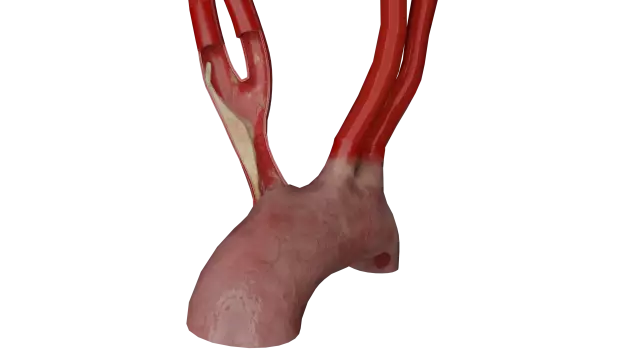- Author Rachel Wainwright [email protected].
- Public 2023-12-15 07:39.
- Last modified 2025-11-02 20:14.
Abdominal aortic aneurysm
The content of the article:
- Forms of the disease
- Causes and risk factors
- Abdominal aortic aneurysm symptoms
- Diagnostics
- Abdominal aortic aneurysm treatment
- Potential consequences and complications
- Forecast
- Prevention
An aneurysm of the abdominal aorta is a local enlargement of the lumen of the abdominal part of the aorta, which develops as a result of pathological changes in its walls or anomalies in their development. Among all aneurysmal lesions of blood vessels, aneurysm of the abdominal aorta is 95%. The disease is diagnosed in every twentieth man over the age of 60, women suffer less often.

Expansion of the lumen of the abdominal aorta with aneurysm
An aneurysm of the abdominal aorta in most cases is asymptomatic, however, it gradually increases in volume (by about 10-12% per year). Over time, the walls of the vessel stretch so much that they are ready to burst at any time. The rupture of the aneurysm is accompanied by massive internal bleeding and death of the patient.
Abdominal aortic aneurysm ranks 15th in the list of diseases leading to death.
Forms of the disease
Most often, clinicians use the classification of abdominal aortic aneurysms, based on the features of the anatomical location of pathological enlargements:
- infrarenal aneurysms, i.e., those located below the branches of the renal arteries (observed in 95% of cases);
- suprarenal aneurysms, i.e., located above the place of origin of the renal arteries.
By the structure of the sac wall, abdominal aortic aneurysms are divided into false and true.
By the form of protrusion:
- exfoliating;
- fusiform;
- diffuse;
- saccular.

Types of aneurysms
Depending on the cause of the abdominal aortic aneurysm, it can be congenital (associated with anomalies in the structure of the vascular wall) or acquired. The latter, in turn, are divided into two groups:
- Inflammatory (infectious, infectious-allergic, syphilitic).
- Non-inflammatory (traumatic, atherosclerotic).
By the presence of complications:
- uncomplicated;
- complicated (thrombosed, ruptured, exfoliating).
Depending on the diameter of the site of expansion, the aneurysm of the abdominal aorta are small, medium, large and giant.
A. A. Pokrovsky proposed a classification of abdominal aortic aneurysms, based on the prevalence of the pathological process:
- Infrarenal aneurysm with long proximal and distal isthmuses.
- Infrarenal aneurysm, located above the level of bifurcation (bifurcation) of the abdominal aorta, with a long proximal isthmus.
- Infrarenal aneurysm extending to the bifurcation region of the abdominal aorta, as well as the iliac arteries.
- Total (infrarenal and suprarenal) aneurysm of the abdominal aorta.
Causes and risk factors
The results of numerous studies have shown that the main etiological factor of an abdominal aortic aneurysm, as well as other localizations of this pathological process (thoracic aorta, aortic arch), is atherosclerosis. In 80-90% of cases, the development of the disease is due to it. Much less often, the development of acquired abdominal aortic aneurysms is associated with inflammatory processes (rheumatism, mycoplasmosis, salmonellosis, tuberculosis, syphilis, nonspecific aortoarteritis).

The main cause of an abdominal aortic aneurysm is atherosclerosis
Often, an aneurysm of the abdominal aorta is formed in patients with congenital inferiority of the structure of the vascular wall (fibromuscular dysplasia).
Reasons for the appearance of a traumatic aneurysm of the abdominal aorta:
- spine and abdominal injuries;
- technical errors in performing reconstructive operations (prosthetics, thromboembolectomy, stenting or dilatation of the aorta) or angiography.
Factors that increase the risk of forming an abdominal aortic aneurysm are:
- smoking - smokers make up 75% of all patients with this pathology, the more smoking experience and the number of cigarettes smoked daily, the higher the risk of aneurysm development;
- age over 60;
- male gender;
- the presence of this disease in close relatives (hereditary predisposition).
Rupture of an abdominal aortic aneurysm most often occurs in patients suffering from chronic bronchopulmonary diseases and / or arterial hypertension. In addition, the size and shape of the aneurysm also affects the risk of rupture. Symmetrical aneurysmal sacs rupture less frequently than asymmetric ones. And giant extensions, reaching 9 cm in diameter or more, burst with massive bleeding and rapid death of patients in 75% of cases.
Abdominal aortic aneurysm symptoms
In most cases, an abdominal aortic aneurysm proceeds without any clinical signs and is diagnosed incidentally by plain abdominal radiography, ultrasound examination, diagnostic laparoscopy, or conventional abdominal palpation performed in connection with another abdominal pathology.
In other cases, the clinical symptoms of an abdominal aortic aneurysm may be:
- pain in the abdomen;
- a feeling of fullness or heaviness in the abdomen;
- a throbbing sensation in the abdomen.
Pain is felt in the left abdomen. Its intensity can be from mild to unbearable, requiring the appointment of anesthetic injections. Often the pain radiates to the groin, sacral or lumbar region, and therefore the diagnosis of sciatica, acute pancreatitis or renal colic is mistakenly made.

Abdominal pain and throbbing may signal an abdominal aortic aneurysm
When a growing abdominal aortic aneurysm begins to exert mechanical pressure on the stomach and duodenum, this leads to the development of dyspeptic syndrome, which is characterized by:
- nausea;
- vomiting;
- belching with air;
- flatulence;
- a tendency to chronic constipation.
In some cases, the aneurysmal sac displaces the kidney and squeezes the ureter, thereby leading to the formation of urological syndrome, which is clinically manifested by dysuric disorders (frequent, painful, difficult urination) and hematuria (blood in the urine).
If an aneurysm of the abdominal aorta compresses the testicular vessels (arteries and veins), the patient develops pain in the testicular area, and also develops varicocele.
The compression of the spinal roots by the increasing protrusion of the abdominal aorta is accompanied by the formation of an ischioradical symptom complex, which is characterized by persistent pain in the lumbar region, as well as movement and sensory disorders in the lower extremities.

When an aneurysm compresses arteries and veins, a man gets varicocele
An aneurysm of the abdominal aorta can cause chronic disturbance of blood supply to the lower extremities, which leads to trophic disorders and intermittent claudication.
When an abdominal aortic aneurysm ruptures, the patient experiences massive bleeding, which can lead to death in a few seconds. The clinical symptoms of this condition are:
- sudden, intense pain (called dagger pain) in the abdomen and / or lower back;
- a sharp drop in blood pressure, up to the development of a collapse;
- sensation of strong pulsation in the abdominal cavity.
Features of the clinical picture of rupture of the abdominal aortic aneurysm are determined by the direction of bleeding (bladder, duodenum, inferior vena cava, free abdominal cavity, retroperitoneal space). For retroperitoneal bleeding, persistent pain syndrome is characteristic. If the hematoma increases towards the small pelvis, then the pain radiates to the perineum, groin, genitals, thigh. High localization of hematoma often manifests itself under the guise of a heart attack.
Intraperitoneal rupture of an aneurysm of the abdominal aorta leads to the rapid development of massive hemoperitoneum, there is a sharp pain and bloating. Symptom Shchetkin - Blumberg is positive in all departments. Percussion determines the presence of free fluid in the abdominal cavity.
Simultaneously with the symptoms of an acute abdomen, when the aortic aneurysm ruptures, the symptoms of hemorrhagic shock appear and rapidly intensify:
- sharp pallor of the mucous membranes and skin;
- severe weakness;
- cold clammy sweat;
- lethargy;
- threadlike pulse (fast, low filling);
- a marked decrease in blood pressure;
- decrease in urine output (amount of urine discharge).
With intraperitoneal rupture of an abdominal aortic aneurysm, death occurs very quickly.
If there is a breakthrough of the aneurysmal sac into the lumen of the inferior vena cava, this is accompanied by the formation of an arteriovenous fistula, the symptoms of which are:
- pain localized in the abdomen and lower back;
- formation of a pulsating tumor in the abdominal cavity, over which systolic-diastolic murmurs are well heard;
- swelling of the lower extremities;
- tachycardia;
- increasing shortness of breath;
- significant general weakness.
Heart failure gradually increases, which becomes the cause of death.
Rupture of an aneurysm of the abdominal aorta into the duodenal lumen leads to sudden massive gastrointestinal bleeding. The patient's blood pressure drops sharply, bloody vomiting occurs, weakness and indifference to the environment increase. Bleeding with this type of rupture is difficult to diagnose from gastrointestinal bleeding due to other causes, for example, gastric ulcer and duodenal ulcer.
Diagnostics
In 40% of cases, an abdominal aortic aneurysm is an accidental diagnostic finding during a clinical or X-ray examination for another reason.
The presence of the disease can be assumed on the basis of data obtained during the collection of anamnesis (indication of family cases of the disease), general examination of the patient, auscultation and palpation of the abdomen. In thin patients, it is sometimes possible to palpate in the abdominal cavity a pulsating painless formation with a tight-elastic consistency. During auscultation, a systolic murmur can be heard over the area of this formation.
The most accessible and cheapest method for diagnosing an abdominal aortic aneurysm is a plain radiography of the abdominal cavity. On the roentgenogram, the shadow of the aneurysm is visualized, and in 60% of cases, there is a calcification of its walls.
Ultrasound examination and computed tomography make it possible to determine the size and localization of pathological enlargement with great accuracy. In addition, according to the computed tomography data, the doctor can assess the relative position of the abdominal aortic aneurysm and other visceral blood vessels, and identify possible anomalies of the vascular bed.

To diagnose an aneurysm of the abdominal aorta, X-ray, ultrasound, CT is required
Angiography is indicated for patients with arterial hypertension with severe or unstable angina pectoris, significant stenosis of the renal arteries, patients with suspected mesenteric ischemia, and patients with symptoms of distal artery occlusion (blockage).
If indicated, other methods of instrumental diagnostics can be used, for example, laparoscopy, intravenous urography.
Abdominal aortic aneurysm treatment
The presence of an abdominal aortic aneurysm in a patient is an indication for surgical treatment, especially if the size of the protrusion increases by more than 0.4 cm per year.
The main operation for aneurysm of the abdominal aorta is aneurysmectomy (excision of the aneurysmal sac), followed by plastic surgery of the removed section of the blood vessel with a prosthesis made of dacron or other synthetic material. Surgical intervention is performed through a laparotomy approach (abdominal incision). If the iliac arteries are also involved in the pathological process, then bifurcation aorto-iliac prosthetics are performed. Before, during and on the first day after the operation, the pressure in the cardiac cavities and the amount of cardiac output are monitored using a Swan-Gantz catheter.

Surgery to remove an abdominal aortic aneurysm is called an aneurysmectomy
Contraindications for performing planned surgery for abdominal aortic aneurysm are:
- acute disorders of cerebral circulation;
- fresh myocardial infarction;
- end stage chronic renal failure;
- severe heart and respiratory failure;
- widespread occlusion of the iliac and femoral arteries (partial or complete blockage of blood flow through them).
In case of rupture of an aneurysm of the abdominal aorta, the operation is performed for health reasons on an emergency basis.
Currently, vascular surgeons prefer minimally invasive methods of treating an abdominal aortic aneurysm. One of them is endovascular prosthetics of the pathological expansion site using an implantable stent graft (special metal construction). The stent is positioned so that it completely covers the entire length of the aneurysmal sac. This leads to the fact that the blood ceases to exert pressure on the walls of the aneurysm, thereby preventing the risk of its further increase, as well as rupture. This operation for abdominal aortic aneurysm is characterized by minimal trauma, a low risk of complications in the postoperative period, and a short rehabilitation period.
Potential consequences and complications
The main complications of an abdominal aortic aneurysm are:
- rupture of the aneurysmal sac;
- trophic disorders in the lower extremities;
- intermittent claudication.
Forecast
In the absence of timely surgical treatment of an abdominal aortic aneurysm, about 90% of patients die within the first year from the moment of diagnosis. Operational mortality during a planned operation is 6-10%. Emergency surgical interventions performed against the background of rupture of the wall of the aneurysm are fatal in 50-60% of cases.
Prevention
For the timely detection of an aneurysm of the abdominal aorta in patients suffering from atherosclerosis or having a burdened history of this vascular pathology, systematic medical supervision with periodic instrumental examination (X-ray of the abdominal cavity, ultrasound) is recommended.
Quitting smoking, active treatment of infectious and systemic inflammatory diseases are of no small importance in the prevention of aneurysm formation.
YouTube video related to the article:

Elena Minkina Doctor anesthesiologist-resuscitator About the author
Education: graduated from the Tashkent State Medical Institute, specializing in general medicine in 1991. Repeatedly passed refresher courses.
Work experience: anesthesiologist-resuscitator of the city maternity complex, resuscitator of the hemodialysis department.
The information is generalized and provided for informational purposes only. At the first sign of illness, see your doctor. Self-medication is hazardous to health!






